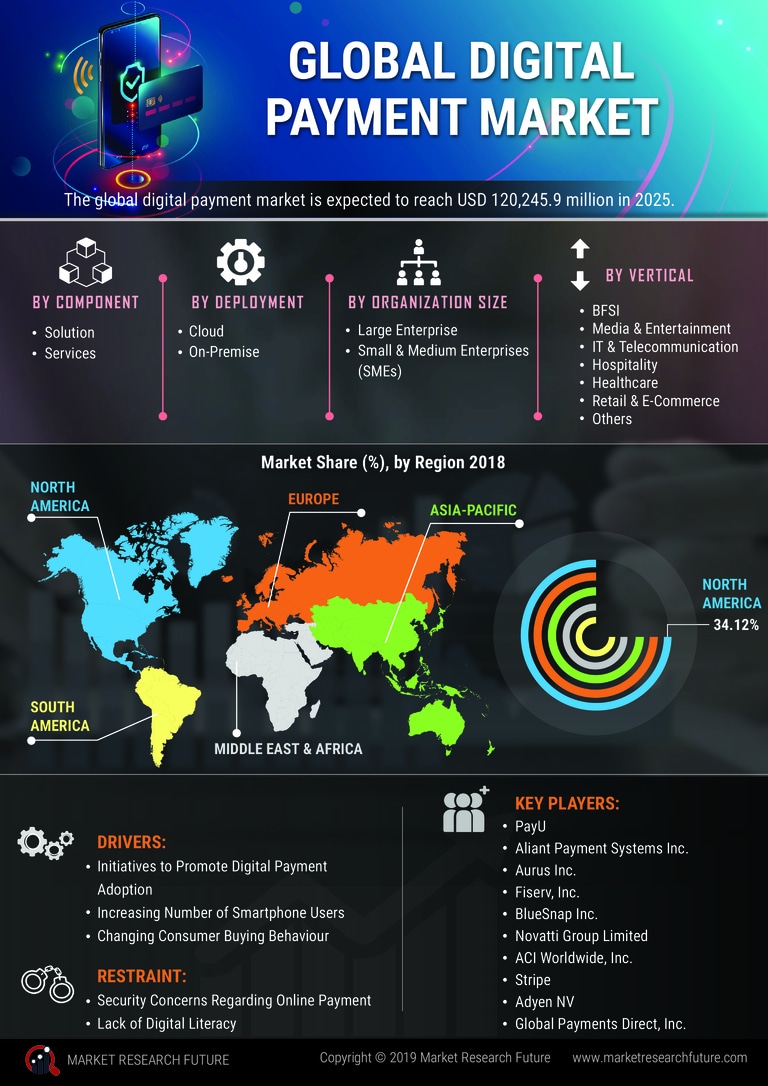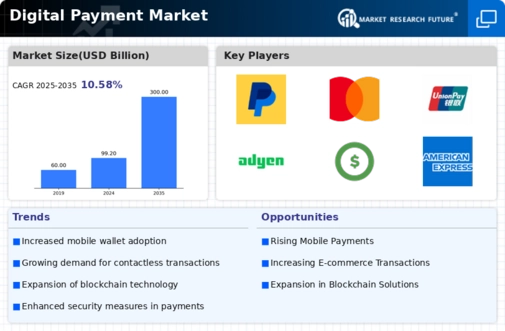Expansion of E-commerce
The rapid expansion of e-commerce platforms has been a pivotal driver for the Digital Payment Market. As consumers increasingly prefer online shopping, the demand for seamless and secure payment solutions has surged. In 2025, e-commerce sales are projected to reach approximately 6 trillion USD, indicating a substantial growth trajectory. This trend compels businesses to adopt digital payment methods to enhance customer experience and streamline transactions. The integration of various payment options, including credit cards, digital wallets, and buy-now-pay-later services, further fuels this growth. Consequently, the Digital Payment Market is likely to witness a significant uptick in transaction volumes, as more consumers opt for online purchases over traditional retail. This shift not only transforms consumer behavior but also encourages merchants to innovate their payment processes to remain competitive.
Growing Smartphone Penetration
The growing penetration of smartphones is a significant driver of the Digital Payment Market. As of 2025, it is estimated that over 80% of the global population will own a smartphone, facilitating access to digital payment solutions. This widespread adoption enables consumers to conduct transactions anytime and anywhere, thereby increasing the frequency of digital payments. Mobile banking applications and digital wallets are becoming increasingly popular, allowing users to manage their finances with ease. The convenience offered by smartphones is likely to encourage more individuals to transition from cash to digital payment methods. Consequently, the Digital Payment Market is expected to experience substantial growth, as businesses adapt to the changing landscape by offering mobile-friendly payment options. This trend not only enhances consumer convenience but also drives innovation in payment technologies.
Adoption of Contactless Payments
The adoption of contactless payment methods is transforming the Digital Payment Market. With the proliferation of Near Field Communication (NFC) technology, consumers are increasingly utilizing contactless cards and mobile wallets for transactions. As of 2025, it is estimated that contactless payments will account for over 30% of all card transactions. This trend is driven by the convenience and speed of contactless payments, which enhance the overall shopping experience. Retailers are also incentivized to implement contactless payment systems to reduce checkout times and improve customer satisfaction. Furthermore, the Digital Payment Market benefits from the growing acceptance of these payment methods across various sectors, including retail, transportation, and hospitality. As more consumers embrace contactless technology, the industry is poised for continued growth, with an emphasis on innovation and user-friendly solutions.
Emergence of Fintech Innovations
The emergence of fintech innovations is reshaping the Digital Payment Market. Startups and established financial institutions are increasingly leveraging technology to develop new payment solutions that cater to evolving consumer needs. Innovations such as blockchain technology, peer-to-peer payment platforms, and instant payment systems are gaining traction. In 2025, the fintech sector is projected to reach a valuation of over 300 billion USD, highlighting the potential for growth within the Digital Payment Market. These advancements not only enhance transaction speed and security but also provide consumers with more choices in how they manage their finances. As fintech companies continue to disrupt traditional banking models, the Digital Payment Market is likely to witness increased competition and collaboration, ultimately leading to a more dynamic and diverse payment landscape.
Regulatory Support and Frameworks
Regulatory support and frameworks play a crucial role in shaping the Digital Payment Market. Governments worldwide are increasingly recognizing the importance of digital payments in promoting financial inclusion and economic growth. In 2025, several countries are expected to implement favorable regulations that facilitate the adoption of digital payment solutions. These regulations may include guidelines for security standards, consumer protection, and interoperability among payment systems. Such supportive measures encourage businesses to invest in digital payment technologies, thereby expanding the market. Moreover, the Digital Payment Market benefits from initiatives aimed at enhancing cybersecurity and combating fraud, which are essential for building consumer trust. As regulatory environments evolve, they are likely to foster innovation and competition, ultimately leading to a more robust digital payment ecosystem.


















Leave a Comment